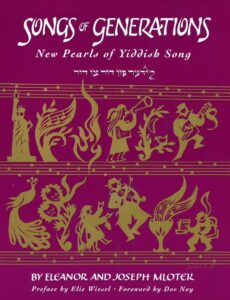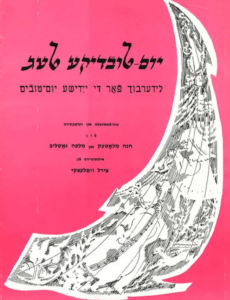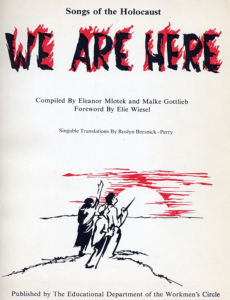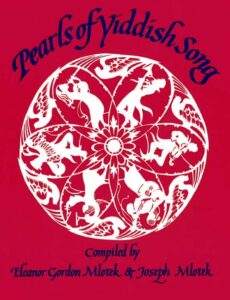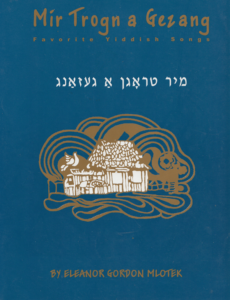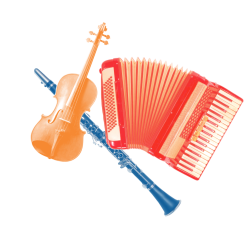Discover the Music
Browse through each song book or search the entire collection.
Search
Am Yisroel Khay
This song was written by M. Knapheise (b. 1910), poet who survived the war in Russia and migrated to Argentina, where he was editor of a Yiddish literary magazine. The music is by S. Beresovsky (1908-1975). The song was written after the Holocaust and was sung in the Displaced Persons camps in Europe.
Am Yisroel Khay!
Words by Soviet Jewish poet Joseph Kerler (born 1918), who emigrated to Israel in 1971. The song was published in the Anthology of Yiddish Folksongs, IV (1987). The accompanying footnote states that “the song was created in the circles of new immigrants from Soviet Russia, which they call ‘gazlen-land’ (the land of bandits).” Actor-singer Theodore Bikel sings: “Khay, khay, zoln zey geyn in dr’erd arayn” (Live, live, let them go to hell!).
Am Yisroel Khay!
This song was written by M. Knapheise (b. 1910), poet who survived the war in Russia and migrated to Argentina, where he was editor of a Yiddish literary magazine. The music is by S. Beresovsky (1908-1975). The song was written after the Holocaust and was sung in the Displaced Persons camps in Europe.
Ani Mamin
Words are based on Maimonides’ thirteen articles of faith. The song expresses confidence in the coming of the Messiah and was sung by Jews in the Warsaw Ghetto who were taken to their death.
Antshuldikt!
One of the “Farbotene lider” (Forbidden Songs) which were sung clandestinely in Soviet Russia in the 1960s. Transcribed by the compilers from a recording by David Eshet, Israel.
Arbeter Froyen
One of the early labor songs directed at working women. Poem by Dovid Edelshtat (1866-1892) and published in New York in Di fraye arbeter shtime (Free Voice of Labor) on May 8, 1891. Text and music published in 1918 by Y. Glatshteyn in Warsaw.
The song was widely disseminated in Eastern Europe. A. Litvak, a leader of the Jewish Labor Bund, writes that “Arbeter-froyen” was one of the first and most popular songs in Tsarist Russia. In a memoir, Abba Levin recalls that during the tanners’ strike in 1897 in Krinek, near Grodno, the strikers sang workers’ songs with great enthusiasm, mainly Edelshtat’s “Arbeter froyen,” “In kamf” (In the struggle), and others. Similarly, memoirist Sholem Levin relates that the song was one of the most popular songs in Minsk in 1896-97. It was revived in the Off-Broadway musical The Golden Land (1982-87).
Arbeter-Ring-Himen
Poem by A. Liessin (1882-1938); the music by Meyer Posner (1890-1931) was the contest-winning melody in 1925. Non-literal translation by S.H. Friedman.
Aroyskumen Zolstu Mayn Meydl
Poem Der Shoymer, by Sh. I. Imber (1889-1942); music by Chaim Ritterband, published in 1935.
Arum Dem Fayer
This song was popular in the 1930’s in Poland and the United States. Published by Mikhl Gelbart in 1938.
Avek Di Yunge Yorn
Folk song published by Y.L. Cahan in 1912. In some versions there are stanzas in Ukrainian.
Avremele un Yosele
Avreml der Marvikher
Az Der Rebe Tantst
Folksong, partial text and music published in 1932 by A. Z. Idelsohn. Alternate title is Az Der Rebe Zingt (When the Rabbi Sings).
A variant in a children’s game song was published in 1916 by Joel Engel. There, instead of Hassidim, “talmidimlekh” (students) imitate “der rebe” (the teacher): “Un az der rebe shteyt… Un as der rebe shpringt…” (When the teacher walks… When the teacher stands… When the teacher jumps…). S. Altman’s version has additionally “Un az der rebe loyft’‘ and “Un az der rebe shvaygt” (When the teacher runs… when the teacher is silent).
There are other versions with the rabbi eating, drinking, laughing, coughing, sneezing, etc. In 90 geklibene lider, 1926 and in Selected Jewish Songs for Members of the Armed Forces, 1949. The melody was used in the Halutsim song “Vu bistu geven, tokhter mayne getraye?” (Where have you been, daughter, dearest mine?).
Az Di Yontefdike Teg
Az Ikh Vel Zogn “Lekho Doydi”
Folksong based on the traditional greeting to the Sabbath bride. Published in Yidisher folklor in Vilna in 1938. In that version, the third stanza refers to the Yiddishist and Zionist movements: “Az ikh vel zogn: tsionistn. . . Az ikh vel zogn yidishistn… Yidishistn vert tsionistn; tshiri-birl-bam” (When I say “Zionists”. . . When I say “Yiddishists”. . . Yiddishists become Zionists).
Singers in the United States added the “tshiribim” refrain from the song “Nisim” (Miracles): “Nisim vel ikh aykh dertseyln” (I will tell you of miracles), c.f. Judith Eisenstein, Heritage of Jewish Music.
Part of the opening melody is similar to Abraham Goldfaden’s “Veynt zhe ale tsions tekhter” (Cry, all you daughters of Zion) from his operetta Bar Kokhba.
Az Ikh Volt Gehat Dem Keysers Oytsres
Part of a popular lullaby with satiric undertones that is included in many collections as an anonymous folksong. Actually written by Maskillic writer Mikhl Gordon (1823-1890), author of song favorites “Di bord” (The beard) and “Di mashke” (Whiskey) and others. Originally published in 1888 in the author’s anonymous collection. Textual variant published in 1901 by S. Ginsburg and P. Marek; text and music published in 1909 by Joel Engel. The whole poem was reprinted in 1974 by Yosl and Chana Mlotek.
Babi Yar
Babi Yar, a ravine on the outskirts of Kiev where 33,771 Jews were machine gunned on September 29-30, 1941, became a mass grave for over 100,000 victims, the majority of them being Jews. Words to the song are by Shike Driz (1908-1971), Soviet Yiddish poet. Music is by Riva Boyarsky (1894-1967), Soviet Jewish composer.
Baleboste-lebn
Folk song
Barikadn
Words by Vilna poet-partisan Shmerke Kaczerginsky (1908-1954), written in 1926. The song was popular in Europe and the U.S. in the 1930s. It was published as an anonymous song by A. Bitter in 1940. In the Memorial Book for S. Kaczerginski (Shmerke Katsherginski-ondenk-bukh), 1955, writer Moishe Knapheis describes in his article “Di freydik lid” (The Joyful Song), how the song “rolled through the Jewish towns of Poland like a golden coin from all the poor homes and workers’ locals, cellars and garrets, from everywhere, the joyful singing spread, trilled out by young, thin little voices.”
Bay Dem Shtetl
Popular children’s song previously published as an anonymous folksong. Actually written by Zalmen Rozental (1892-1959). Text and music published in 1925 by M. Kipnis. In some versions (cf., Mlchel Gelbart, 1937-38) the song begins with “Dort in shtetl.” In Lomir, kinder, zingen, there is an additional stanza: “Brengt a tsigl, meket, meket,/ Shoklt mitn berdl,/ Shpant men ayn di tsig in vogn,/ Vert fun tsig a ferdl.” (He brings a goat that bleats, shakes its beard. They harness the goat to the wagon and the goat becomes a horse). A different melody was recorded by Cantor Moyshe Oysher.
Bayt Zhe Mir Oys A Finfuntsvantsiker
Folk song published by M. Kipnis in 1925, where he notes that this is sung by the mekhuteneste at a wedding. The last chorus he writes “is sung and danced slowly.” The folklorist Ruth Rubin gives an additional explanation: “A wedding guest keeps tipping the band till his legs can no longer move so fast.”
Belz
One of the most popular Yiddish theatre songs that arose in the United States that expressed longing for hometowns in Eastern Europe. Text by Jacob Jacobs (1892-1972); music by Alexander Olshanetsky (1892-1946), written for Olshanetsky’s play The Song of the Ghetto.
Poet-folklorist S. Kaczerginski relates in Khurbn vilne that during the Holocaust the Nazis forced the Jews of the Vilna Ghetto to sing before each meal. The Jews’ favorite songs were “Vu zaynen mayne zibn gute yor?” (Where are my seven good years?) and “Belz.”
Bin Ikh Mir A Khosidl
Folksong published in 1911 by Z. Kisselgof. The words are cited earlier by Sholom Aleichem in his novel Blondzhende shtern (Vagabond Stars), 1909-1910. In one version, collected by J. Gorelik in Yeda am, 31-32, 1967, the stanzas span the entire Hebrew alphabet.
Blimelekh Tsvey
Music by Peretz Sandler (1881-1926), from the play Mendl in yapan (Mendel in Japan). Published in 1924. The song was one of the favorites of compiler Chana Mlotek’s father Leo Gordon, of blessed memory.

